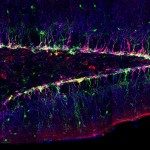Link to Pubmed [PMID] – 36008397
Link to DOI – 10.1038/s41467-022-32685-3
Nat Commun 2022 Aug; 13(1): 4999
Neural stem cells (NSCs) live in an intricate cellular microenvironment supporting their activity, the niche. Whilst shape and function are inseparable, the morphogenetic aspects of niche development are poorly understood. Here, we use the formation of a glial niche to investigate acquisition of architectural complexity. Cortex glia (CG) in Drosophila regulate neurogenesis and build a reticular structure around NSCs. We first show that individual CG cells grow tremendously to ensheath several NSC lineages, employing elaborate proliferative mechanisms which convert these cells into syncytia rich in cytoplasmic bridges. CG syncytia further undergo homotypic cell-cell fusion, using defined cell surface receptors and actin regulators. Cellular exchange is however dynamic in space and time. This atypical cell fusion remodels cellular borders, restructuring the CG syncytia. Ultimately, combined growth and fusion builds the multi-level architecture of the niche, and creates a modular, spatial partition of the NSC population. Our findings provide insights into how a niche forms and organises while developing intimate contacts with a stem cell population.




